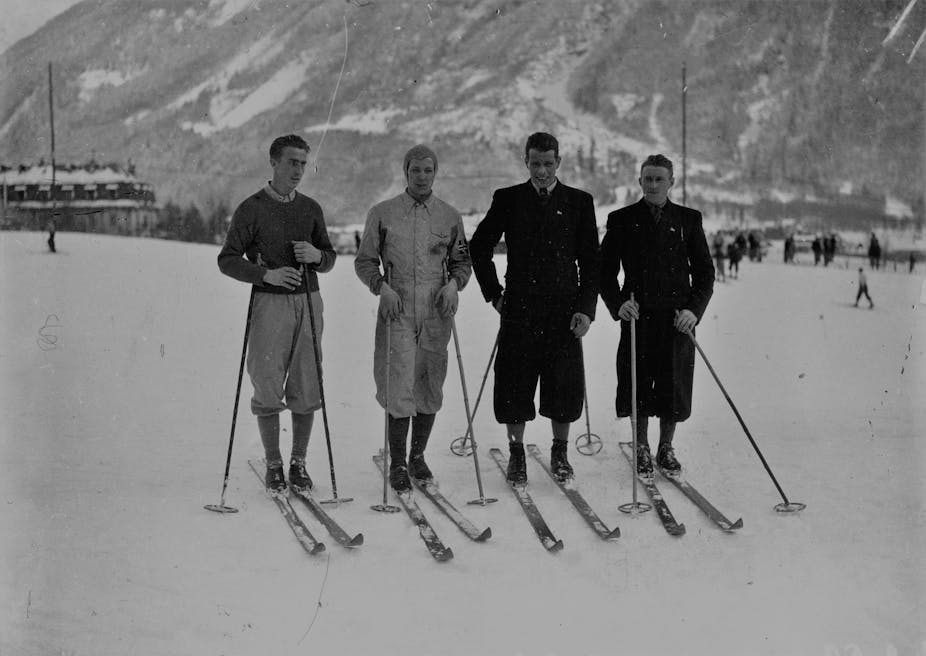Beyond their cornerstone role in athletics, the Olympic Games have long been an event of economic and political importance. The recent decision by South and North Korea to compete under one united flag during this year’s competition shows the international relations possibilities the Olympics offer. The economic impact on the host city is also undeniable – although this can be positive or negative, as some Olympics cost more than they deliver.
The competitive bidding process to host the Olympics means that national governments face a game of chicken-or-egg: do they put forward a city chosen for its robust infrastructure, or one that could use the Games to develop it? The London 2012 Olympic Games are an example, which saw an unloved, ex-industrial part of London entirely redeveloped in the course of preparations for the games. Huge amounts of infrastructure were also built in Sochi for the 2014 Winter Games.
This has been a feature since the first Winter Olympics, which opened in Chamonix-Mont-Blanc in the French Alps in 1924. The choice of Chamonix for what was originally known as the International Winter Sports Week was not an innocent one, and perfectly illustrates the line walked between choosing a place with a strong reputation, and harnessing the impetus of the games to improve it.
First for Alpinists
Once a small parish at the very top of the Arve valley, the first foreign travellers to write about the area were William Windham and Robert Pococke, who visited in 1741. Windham and Pococke were fascinated by the valley’s high peaks, numerous glaciers, unique wildlife and local communities. Soon Chamonix had become a must-see destination for travellers on their European “Grand Tour”, easily accessible from Geneva or on their way to Italy.
Perhaps the highlight of a visit is the sight of Mont Blanc, the Alps’ highest peak at 4,810 metres. Mont Blanc was first scaled in 1786 by Dr Michel-Gabriel Paccard and Jacques Balmat, his local guide. Since then, Chamonix has been regarded as the capital of Alpinism and mountaineering.
As the Enlightenment faded and the Industrial Revolution began, tourism went from a marginal pastime of elites to a booming mass market, supported by new developments such as railways and hotels. In many respects, the Swiss resorts such as Interlaken or St Moritz grew faster, as that country’s reputation developed into that of a mountainous nation, proud of its natural heritage.
After the Duchy of Savoy in which Chamonix resided was annexed by France in 1860, Chamonix continued to transition from a romantic travel destination to a place of mass tourism. A tourism board was founded in 1912 to deliver a consistent tourism policy in the entire valley, and in 1913 Bradshaw’s Continental Railway Guide and General Handbook described Chamonix as follows:
Chamonix, in Dept. Haute Savoie, is visited by an ever increasing number of travellers because of the surpassing grandeur of its mountain scenery; it has become a centre for winter sports.

By the turn of the 20th century, Chamonix had become a model for Alpine tourism. The decision to hold the first Winter Olympics in Chamonix was therefore a result of this solid reputation, and also the desire to turn Chamonix into the leading venue for winter sports, ahead of other locations.
In 1921, ahead of the games, the town council of Chamonix decided to rename the town Chamonix-Mont-Blanc. This was officially to prevent confusion with other similar-sounding town names for the postal services, but clearly the real reason was for tourism promotion: Chamonix would become forever associated with the Alps’ highest peak. Chamonix remains a world-class mountain resort today, partly because its reputation is undeniably linked to these pioneering events, the first scaling of the mountain, and the first Winter Games.
To have or to build
This subtle balance can still be seen today: candidate cities play on their robust history of sports, leisure and tourism, but inevitably also apply in order to develop and bolster that reputation. The 2014 Sochi Winter Olympics, held as Crimea was plunged into a diplomatic crisis, revitalised the area’s reputation for tourism it had during the Soviet era. It will even host football matches during the Russia 2018 FIFA World Cup.
For the current 2018 Winter Games underway in Korea, the fairly popular resort of Pyeongchang in the South has worked closely with local tourism authorities to turn the city into a global winter resort after this year’s games. Having lost out to London in 2012, Paris was last year awarded the 2024 Summer Olympics with a bid that seduced the committee with Parisian magic and enthusiasm. The city will look forward to the economic boost required to renew the city’s infrastructure, while hoping to sweep aside memories of the huge cost overruns that marred France’s last hosted Olympics, Albertville in 1992.
Hosting the Olympics is a true test for a city’s claim for global recognition: confirming their membership of a small circle of “world cities”, or an opportunity to join the club. But just winning the Olympic bid is not success: the real feat lies in building and organising what is required for the games, and in making sure the outcome of these few weeks leaves a beneficial legacy.
In London, this has seen continued use of sporting venues and the Olympic village repurposed as badly-needed housing, although debate over who benefits remains. In Athens, the venues lie rotting, unused, in the years since, while the huge cost overrun arguably drove Greece to bankruptcy. For the most part, except for coverage of the two weeks themselves, discussion of the Olympics deserves to be anywhere but a newspaper’s sports section.

